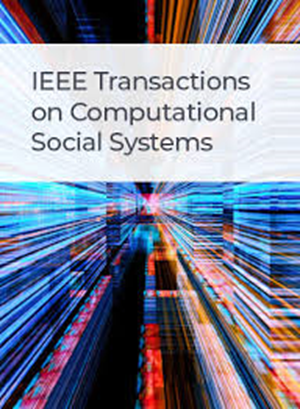A Multimodal Latent-Features-Based Service Recommendation System for the Social Internet of Things
IF 4.5
2区 计算机科学
Q1 COMPUTER SCIENCE, CYBERNETICS
IEEE Transactions on Computational Social Systems
Pub Date : 2024-02-21
DOI:10.1109/TCSS.2024.3360518
引用次数: 0
Abstract
The Social Internet of Things (SIoT) is revolutionizing how we interact with our everyday lives. By adding the social dimension to connecting devices, the SIoT has the potential to drastically change the way we interact with smart devices. This connected infrastructure allows for unprecedented levels of convenience, automation, and access to information, allowing us to do more with less effort. However, this revolutionary new technology also brings an eager need for service recommendation systems. As the SIoT grows in scope and complexity, it becomes increasingly important for businesses and individuals, and SIoT objects alike to have reliable sources for products, services, and information that are tailored to their specific needs. Few works have been proposed to provide service recommendations for SIoT environments. However, these efforts have been confined to only focusing on modeling user-item interactions using contextual information, devices’ SIoT relationships, and correlation social groups but these schemes do not account for latent semantic item–item structures underlying the sparse multimodal contents in SIoT environment. In this article, we propose a latent-based SIoT recommendation system that learns item–item structures and aggregates multiple modalities to obtain latent item graphs which are then used in graph convolutions to inject high-order affinities into item representations. Experiments showed that the proposed recommendation system outperformed state-of-the-art SIoT recommendation methods and validated its efficacy at mining latent relationships from multimodal features.基于多模态潜特征的社交物联网服务推荐系统
社交物联网(SIoT)正在彻底改变我们与日常生活的互动方式。通过为连接设备添加社交维度,SIoT 有可能彻底改变我们与智能设备的互动方式。这种互联基础设施带来了前所未有的便利、自动化和信息获取水平,使我们能够事半功倍。然而,这项革命性的新技术也带来了对服务推荐系统的迫切需求。随着 SIoT 的范围和复杂性不断扩大,对于企业和个人以及 SIoT 对象来说,拥有可靠的产品、服务和信息来源以满足其特定需求变得越来越重要。为 SIoT 环境提供服务建议的工作很少。然而,这些工作仅限于利用上下文信息、设备的 SIoT 关系和相关社会群体对用户-物品交互进行建模,但这些方案并没有考虑到 SIoT 环境中稀疏的多模态内容所蕴含的潜在语义物品-物品结构。在本文中,我们提出了一种基于潜语义的 SIoT 推荐系统,该系统可学习项目-项目结构并聚合多种模态以获得潜语义项目图,然后将其用于图卷积,从而为项目表征注入高阶亲和力。实验表明,所提出的推荐系统优于最先进的 SIoT 推荐方法,并验证了其从多模态特征中挖掘潜在关系的功效。
本文章由计算机程序翻译,如有差异,请以英文原文为准。
求助全文
约1分钟内获得全文
求助全文
来源期刊

IEEE Transactions on Computational Social Systems
Social Sciences-Social Sciences (miscellaneous)
CiteScore
10.00
自引率
20.00%
发文量
316
期刊介绍:
IEEE Transactions on Computational Social Systems focuses on such topics as modeling, simulation, analysis and understanding of social systems from the quantitative and/or computational perspective. "Systems" include man-man, man-machine and machine-machine organizations and adversarial situations as well as social media structures and their dynamics. More specifically, the proposed transactions publishes articles on modeling the dynamics of social systems, methodologies for incorporating and representing socio-cultural and behavioral aspects in computational modeling, analysis of social system behavior and structure, and paradigms for social systems modeling and simulation. The journal also features articles on social network dynamics, social intelligence and cognition, social systems design and architectures, socio-cultural modeling and representation, and computational behavior modeling, and their applications.
文献相关原料
| 公司名称 | 产品信息 | 采购帮参考价格 |
|---|
 求助内容:
求助内容: 应助结果提醒方式:
应助结果提醒方式:


